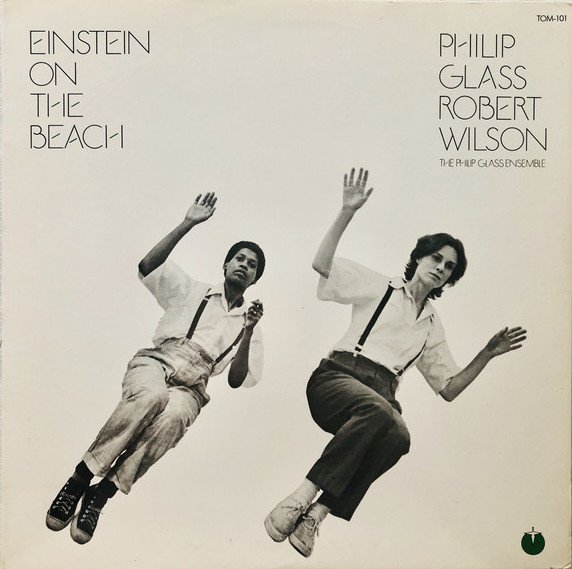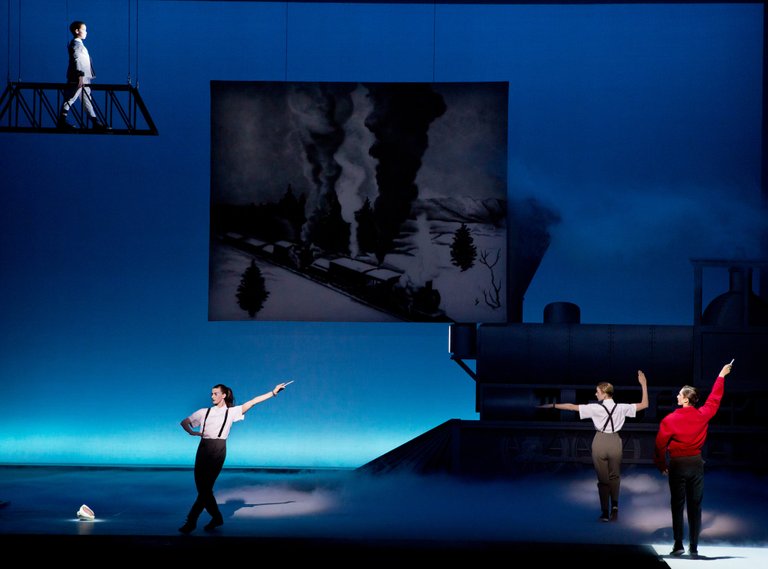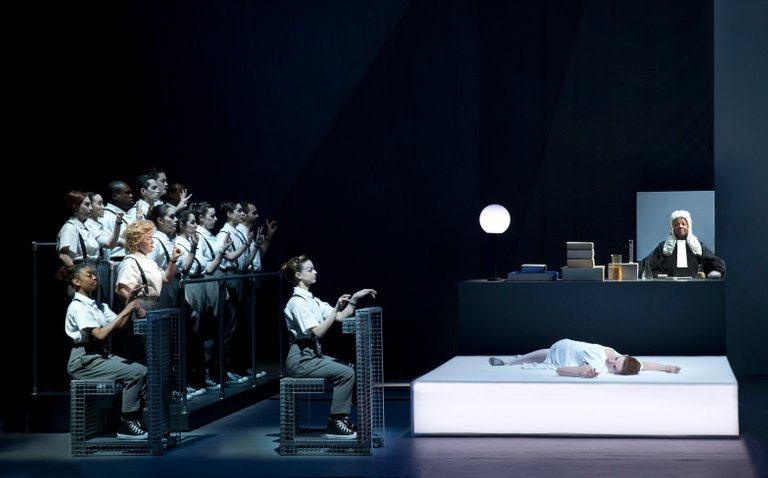Einstein on the Beach - Philip Glass - 1979 // Review
Continuing the project of studying Philip Glass' discography, here is one of his most famous early works (and one of the first available on Spotify), I confess that it was not a work that I liked very much, I believe he has much better things but by the fact that there are so many works it may take me a long time to find my preferences.

Source
Apparently this is Glass' second recorded album. It is an opera with the co-participation of Robert Wilson. Mathematical pattern and the logics of physics for example, are the target themes of this work. Here we see the classic rhythmic crescendo and diminuendo of the pieces. The libretto co-written by Wilson brings the plot of the repetitive and fragmented phrases that make up the structure of the tracks. The album features an amalgam of electronic and acoustic instruments. According to the sources I found, this work is a hybrid work of art, in addition to the Opera itself as the main work, it is also a visual presentation, of "experimental theater", where each track has iconic images that represent it visually. This album made Glass' initial fame to the world.

Source
The first track Knee Play 1 already shows the classic structure you can expect from Glass, a melodic background and a group of voices interspersing and crossing each other in a continuous phrasing of sequentially dictated numbers and growing vertiginously. Track number two Act 1, scene 1 - Train emulates in an almost lysergic and catatonic way through the sounds the sensation of a train. Unfortunately I couldn't find the lyrics to analyze it more intensely, but what I do know is that the vocal work of interleaving phrases together with the vertiginous melodic pattern of the wind instruments that give a kind of catatonic torpor after a few minutes (and the track has, remember: seventeen minutes), produces a high level effect and here we can see why Philip Glass came to the world. Without a doubt we have the junction (or rupture) of classical music with the complex experimental Dadaist music of profound power. Around minute eleven the music begins to take on nauseating contours, as if you were trapped for too long in an amusement park toy and the thin film of the ludicrous reality of the colors of the environment unveils itself and you have to deal with the smell of grease from the toys, the popcorn fallen on the mud and trampled, the dogs that have lost their master and run like crazy through the crowd, The Ferris wheel seems in slow motion while the Loop looks like a human centrifuge screeching mechanically along with the chorus of amazement from all the crew members who smell cheap and nauseating perfume inside their optional cage. As much as I enjoyed it it almost had me googling if by any chance people used to leave in the middle of the Glass pieces to avoid a gush of multicolored vomit from the unsuspecting audience who are fighting tooth and nail to stay sane in their seats as the seventeen minutes crumble any sanity of the being vi who risks this journey.

Source
As sudden as the end of Train comes, Act I, scene 2 - Trail begins, with DOUBLE the tempo.No less dizzying, but at least calmer, the track comes in a repetitive but growing pattern of voices and wind notes, along with a few phrases spoken by a man and a child, one repeating what the other says, something about "This court is now in session" or the like, the voices in chorus continue their "mantra" work forming a solid wall of sound behind the voices. A violin takes over the main space halfway through the track, making the experience more relieving than worrisome, especially as it stays in an un-agonizing circle of notes. At one point the oh-so-simple violin line reminds one of a student practicing a scale or something, but the choir resurfaces from time to time bringing more brightness and detail to the track. Around the eighteen minute mark a declamation of something about Paris begins, the only thing I could pick up from this sort of braggart's speech is "There is a saying: -If you have not been kissed by a lady in Paris, you have never been kissed." In Knee Play 2 we have a girl repeating and fragmenting certain phrases, changing some words and overlapping them continuously, accompanied by a continuous violin in that repetitive classic Glass pattern. A short but not so striking track. When the girl starts a count (one, two, three...) and fits her words into the tempo of the violin notes the play becomes more fun, and ends up making the song a kind of experiment on the tempo/compass of the track. The track Act III, Scene 2 - Dance 2 "Fields with Spaceship" is extremely annoying and I can imagine how torturing it must have been for the hired musicians, with its 17 minutes it even causes migraine by the middle of the duration, the repetition is almost absurd and demotivates the listener to make an effort to go until the end. In Knee Play 4 we have a beautiful violin phrase accompanied by male vocals in a track with a much more palatable tempo (six minutes), but not unlike the others, this one seems to bring vocal and musical exercises where it seems that the musicians are just exercising "Do Re Mi Fa Sol La" scales? The impression is that this album is much longer than it should be, and some of these tracks are there just to annoy the listener. Act IV, Scene 1- Building gives the impression of a general breakdown in the control panel of a big machine where all the controls are flashing madly and the engineers are running around like beasts without knowing what to do, all this rendered by a system of 32 bits at most. In its sequence then comes a solo that seems to be an organ solo, I imagine performed by Philip Glass in Scene 2, "Bed". This track nicely harmonizes Glass' repetitive yet creative and elastic melodic pattern without being strenuous and boring. Around the four-minute mark a beautiful lyrical vocal comes in that complements the (possibly synthetic) instrumentation, thus giving a melancholy and somewhat mystical feel to the track. The penultimate track "Spaceship" brings again the schizoid chorus of voices chanting confused monosyllables in a repetitive and nauseating scale along with a keyboard or something in that classic nausea caused by Glass, this being another long track (13 minutes) we have some changes, nuances and variations in the melody, which little by little jumps from one variation to another and not only melodically but also in terms of tempo and time signature. The circulatory concept in Glass' music is printed in all tracks and can be seen in countless examples, it is as if his melodic phrases are stuck in circles and always end up going back to the first note, never ending up in a new section or a different melody without repeating it hundreds of times before. The album ends with Knee Play 5, with the already known chorus count (one, two, three, four, five, six...) along with a monologue by a girl (I don't know what she's talking about, I didn't have access to the lyrics). About half way through the track a male monologue enters interspersed with the female monologue and the choir, giving a multiple texture to the wall of sound along with the violin phrasing that harmonizes everything else.
Rate: 04

Português
Dando continuidade ao projeto de estudar a discografia de Philip Glass, aqui está um de seus primeiros trabalhos mais famosos (e um dos primeiros disponíveis no Spotify), confesso que não foi um trabalho que gostei muito, creio que ele tem coisas muito melhores mas mediante o fato de haver tantos trabalhos talvez eu leve muito tempo para encontrar minhas preferências.

Source
Ao que tudo indica este é o segundo álbum gravado por Glass. Trata-se de uma Ópera com a co-participação de Robert Wilson. O padrão matemático e as lógicas da física por exemplo, são os temas alvos deste trabalho. Aqui vê-se o clássico crescendo e diminuendo rítmico das peças. O libreto coescrito por Wilson traz a trama das frases repetitivas e fragmentadas que compõem a estrutura das faixas. O álbum possui uma amálgama de instrumentos eletrônicos e acústicos. Segundo as fontes que encontrei, este trabalho é uma obra de arte híbrida, além da Ópera em si, como trabalho principal, é também uma apresentação visual, de “teatro experimental”, onde cada faixa possui imagens icônicas que representam-na visualmente. Este álbum fez a fama inicial de Glass ao mundo.

Source
A primeira faixa Knee Play 1 já mostra a estrutura clássica que se pode esperar de Glass, uma base melódica de fundo e um grupo de vozes intercalando-se e atravessando-se em um fraseado contínuo de números ditados sequencialmente e crescendo vertiginosamente. A faixa número dois Act 1, scene 1 - Train emula de forma quase lisérgica e catatônica através dos sons a sensação de um trem. Infelizmente não encontrei a letra da faixa para poder analisá-la de forma mais intensa, mas o que sei é que o trabalho vocal de intercalações das frases juntamente ao vertiginoso padrão melódico dos instrumentos de sopro que dão uma espécie de torpor catatônio depois de alguns minutos (e a faixa tem, vejam bem: dezessete minutos), produz um efeito de alto nível e aqui podemos ver para que veio Philip Glass ao mundo. Sem dúvidas temos a junção (ou ruptura) da música erudita com o experimental complexo e dadaísta de profunda potência. Lá pelo minuto onze a música começa a tomar contornos de náusea, como se você estivesse preso por tempo demais em um brinquedo de um parque de diversões e a fina película da realidade ludibriante das cores do ambiente descortina se e você tivesse que lidar com o cheiro da graxa dos brinquedos, a pipoca caída no barro e pisoteada, os cães que perderam seu dono e correm como loucos em meio à multidão, batendo-se nas pernas de crianças que choram, palhaços assustadores pintados em aerógrafo na lataria enferrujada de brinquedos datados e perigosos, a roda gigante parece em câmera lenta enquanto o Loop parece uma centrífuga humana berrando mecanicamente junto ao coro de assombro de todos os tripulantes que cheiram perfume barato e nauseante dentro de sua gaiola opcional. Por mais que eu tenha gostado quase me fez pesquisar no Google se por acaso pessoas costumavam sair no meio das peças de Glass para evitar um jorro de vômito multicolorido da platéia desavisada que está lutando com unhas e pernas para manter-se sã nos seus lugares enquanto os dezessete minutos desmoronam qualquer sanidade do ser vi que arriscar-se nessa jornada.

Source
Tão súbita quanto vem o fim de Train, começa a Act I, scene 2 - Trail, com o DOBRO de tempo.Não menos vertiginosa, mas ao menos mais calma, a faixa vem num repetitivo porém crescente padrão de vozes e notas de sopro, juntamente a algumas frases ditas por um homem e uma criança, um repete o que o outro diz, algo sobre “Essa corte agora está em sessão” ou coisa do tipo, as vozes em coro continuam seu trabalho de “mantra” formando uma sólida parede sonora por trás das vozes. Um violino ganha o espaço principal pela metade da faixa, tornando a experiência mais aliviante do que preocupante, principalmente por manter-se num círculo de notas pouco agonizante. Em determinado momento a linha tão simples de violino lembra um aluno praticando escala ou coisa do tipo, porém o coral ressurge de tempo em tempo trazendo mais brilho e detalhes à faixa. Lá pelos dezoito minutos começa uma declamação de alguma coisa sobre Paris, a única coisa que consegui pegar dessa espécie de discurso de um fanfarrão é “Existe um ditado que diz: -Se você não foi beijado por uma dama em Paris, você nunca foi beijado”. Em Knee Play 2 temos uma moça repetindo e fragmentando determinadas frases, mudando algumas palavras e sobrepondo-as de forma contínua, acompanhada por um violino contínuo naquele padrão clássico repetitivo de Glass. Uma faixa curta mas não tão marcante. Quando a moça começa uma contagem (one, two, three…) e encaixar suas palavras no tempo das notas do violino a brincadeira fica mais divertida, e acaba por tornar a música uma espécie de experimento sobre o tempo/compasso da faixa. A faixa Act III, Scene 2 - Dance 2 “Fields with Spaceship” é extremamente irritante e imagino o quanto deve ter sido torturante para os músicos contratados, com seus 17 minutos ela chega a causar enxaqueca já pela metade da duração, a repetição é quase absurda e desmotiva bastante o ouvinte a se esforçar para ir até o final. Em Knee Play 4 temos uma bela frase de violino acompanhada por vocais masculinos numa faixa com um tempo muito mais palatável (seis minutos), mas não diferente de outras, esta parece trazer exercícios vocais e musicais onde parece que os músicos estão apenas exercitando escalas “Do Re Mi Fa Sol La”... A impressão que fica é que esse álbum é muito mais longo do que deveria ser e algumas dessas faixas estão ali apenas para irritar o ouvinte. Act IV, Scene 1- Building dá impressão de um pane geral no painel de controles de uma grande máquina onde os comandos todos estão piscando loucamente e os engenheiros correm como bestas sem saber o que fazer, tudo isso renderizado por um sistema de no máximo 32 bits. Em sua sequência vem então um solo que parece ser de Órgão, imagino eu executado por Philip Glass em Scene 2, “Bed”. Essa faixa harmoniza muito bem o padrão melódico repetitivo porém criativo e elástico de Glass sem ser extenuante e entediante. Pelos quatro minutos entra um vocal lírico belo que complementa o (possivelmente sintético) instrumento, dando assim um ar melancólico e um tanto místico para a faixa. A penúltima faixa “Spaceship” traz novamente o coro esquizo de vozes entoando monossílabas confusas em uma escala repetitiva e nauseante juntamente a um teclado ou coisa do tipo naquela clássica náusea causada por Glass, sendo essa mais uma faixa longa (13 minutos) temos algumas mudanças, nuances e variações na melodia, que pouco a pouco salta de uma variação para outra e não só melodicamente mas também em termos de andamento e compasso. O conceito circulatório na música de Glass está impresso em todas as faixas e pode ser vista em inúmeros exemplos, é como se suas frases melódicas estivessem presas em círculos e acabam sempre voltando para a primeira nota, jamais acabando-se em um novo trecho ou numa melodia diferente sem que repita-se centenas de vezes antes. O álbum acaba com Knee Play 5, com a contagem já conhecida do coral (one, two, three, four, five, six…) juntamente a um monólogo de uma moça (não sei do que ela fala, não tive acesso às letras). Pela metade da faixa entra então um monólogo masculino intercalado ao monólogo feminino e ao coral, dando então uma textura múltipla para o paredão sonoro juntamente com o fraseado de violino que harmoniza todo o resto.
Nota: 04
Your post was manually curated by @Shiftrox.
Delegate your HP to the hive-br.voter account and earn Hive daily!
🔹 Follow our Curation Trail and don't miss voting! 🔹